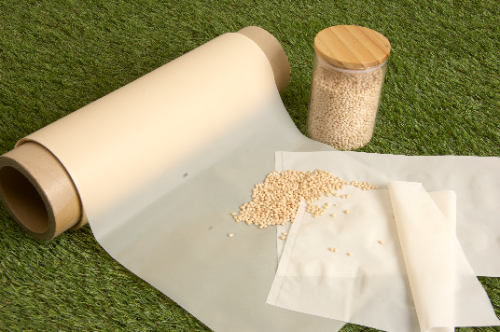What Is a Biodegradable Film?

A biodegradable film is a type of plastic that is ultimately decomposed to the molecular level by the action of microorganisms, resulting in water and carbon dioxide.
In general, plastics are synthetic polymers derived from petroleum, which are difficult to decompose in the natural world.
Therefore, conventional plastics that are buried in the soil or dumped into the ocean remain for a long time without returning to nature. This is becoming a serious environmental problem.
Biodegradable film, on the other hand, is decomposed by microorganisms that exist in the natural world. It is attracting attention as a plastic that can be recycled as a resource.
Uses of Biodegradable Film
Biodegradable films are mainly used for agricultural and civil engineering materials, food waste collection bags, and food container packaging. Some examples are shown below:
1. Mulch Sheets for Agriculture
Biodegradable film is used in agricultural mulch sheets. Agricultural mulch sheets are used to cover field beds and are effective in regulating soil temperature, retaining moisture, and controlling weeds and diseases. The use of biodegradable film in agricultural mulch sheets can greatly reduce the labor required to collect and dispose of used mulch sheets.
2. Food Waste Collection Bags
Biodegradable film is also attracting attention as an alternative to food waste collection bags. If biodegradable film is used as food waste collection bags and processed directly in composting and methane gas fermentation facilities, food waste can be recycled without waste.
3. Marking Tape
Marking tape is mainly used to mark trees in mountain forests. Commonly known as “red tape,” it is used for hazard avoidance, course signage, landmarking, and patrol purposes. The use of biodegradable film eliminates the need to remove it and does not affect the trees.
4. Vegetable Broadcasting Film
Vegetable broadcast film is used to protect the quality of vegetables. This form of packaging is essential for the sale and transportation of vegetables and consumes a lot of plastic. By incorporating biodegradable film as an alternative to existing plastics, you can conduct your business in an environmentally friendly and ecological manner.
Characteristics of Biodegradable Film
The raw materials for biodegradable film can be broadly classified into petroleum-derived biodegradable plastics and plant-derived biodegradable plastics. Polyvinyl alcohol (PVA) is the most common petroleum-derived material, while polylactic acid (PLA) is the most common plant-derived material.
Although biodegradable film is considered to have a low environmental impact, it is not necessary to replace all plastic products with biodegradable film. The priority of replacement is considered based on whether biodegradability is necessary for plastic products that have an environmental impact.
The criteria used to determine this are whether the product is durable or non-durable and whether there is sufficient recovery of the product. High priority is given to non-durable materials that have not been recovered to a great extent.
Typical examples are fishing lines and fish nets, which account for about 41% of litter by weight. If these materials are made biodegradable, even if they are released into the environment, they will be decomposed by microorganisms in the ocean, enabling resource recycling.
Types of Biodegradable Film
In general, plastics are classified into thermoplastics and thermosetting plastics.
However, biodegradable plastics include only thermoplastics.
This is because the film must decompose at a faster rate. Chemical structures that can be biodegradable include aliphatic polyesters and aliphatic polyamides, all of which are thermoplastics.
Plastics that are biodegradable include the following types:
1. PLA
PLA is a plant-derived plastic called polylactic acid and is classified as a bioplastic. It is mainly composed of starch from corn, sugar beets, potatoes, etc., and is biodegradable.
2. Cellulose Acetate (Diacetate)
Cellulose acetate is made from wood-derived fibers and cotton. It is produced by esterification of the extracted cellulose with acetic acid. It is valued as a biomass resource because it is ultimately decomposed into water and carbon dioxide.